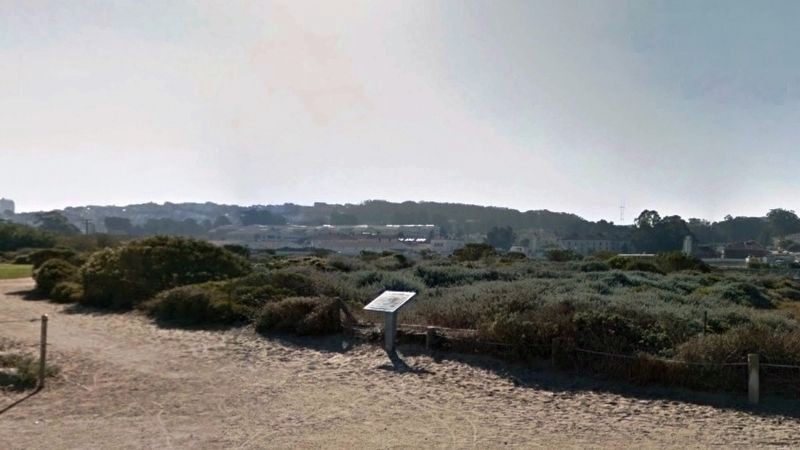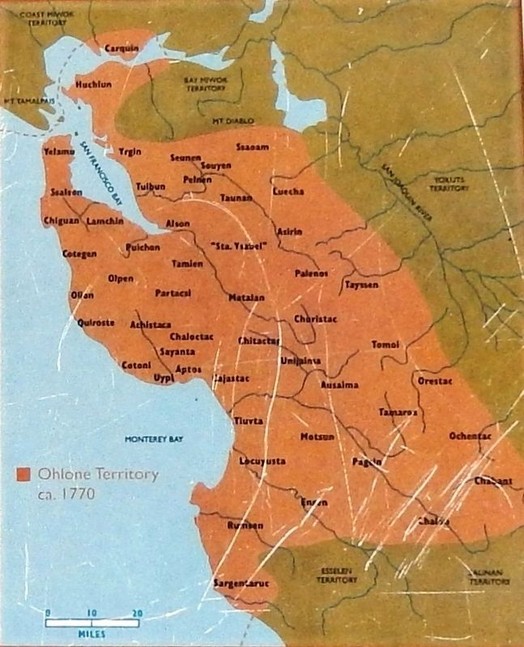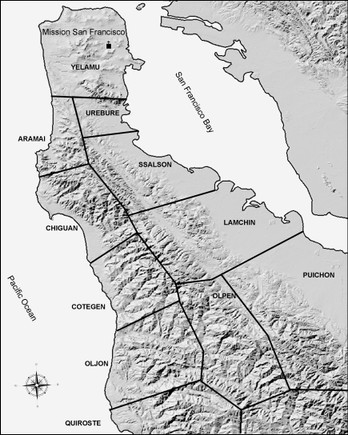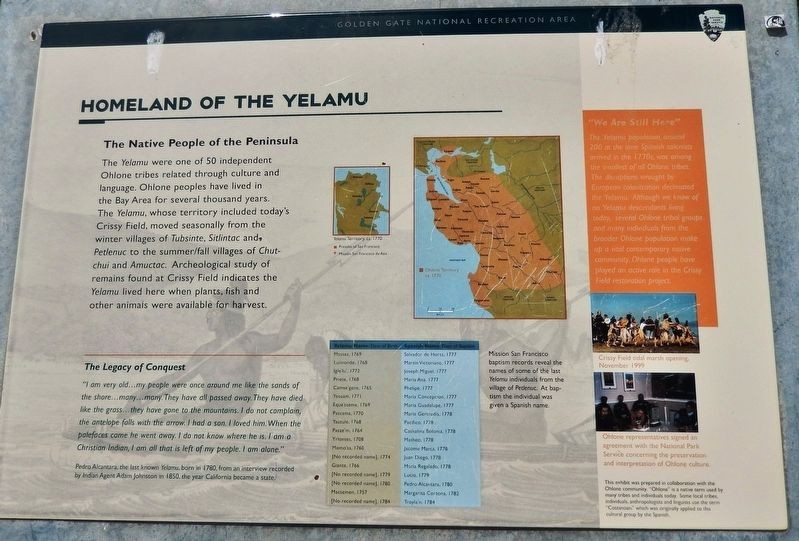Homeland of the Yelamu Historical Marker
Introduction
Author-Uploaded Audio
00:00 / 00:00
Listen to a narration of this entry's description by Jenevieve Hughes.
Text-to-speech Audio
Images
A wide view of the Homeland of the Yelamu Historical Marker, as seen when looking south from Crissy Field Beach

Map of the Ohlone Homeland, circa 1770

Crissy Field, before and after restoration of the tidal marshland in 1999

Map of Ohlone Tribal Groups in the Bay Area and San Francisco peninsula

Homeland of the Yelamu Historical Marker

Mission San Francisco Baptism Registry, which shows the names of some of the last living people of the Yelamu tribe who came from a village called Petlenuc. Upon being baptized, each Yelamu person was given a Spanish name.

Backstory and Context
Author-Uploaded Audio
00:00 / 00:00
Listen to a narration of this entry's description by Jenevieve Hughes.
Text-to-speech Audio
The Yelamu were one of the 50 indigenous Ohlone tribes, which had lived in the Bay Area for thousands of years. The various tribes which comprised the Ohlone people were related through shared aspects of their culture and language. When the Spanish arrived in the Bay Area in 1770, the Yelamu tribe was one of the smallest groups of these Ohlone people. They were comprised of only a couple dozen extended family groups, totaling around 15 members within each kin group.
Their language, which was called Ramaytush, has also been used as a term of identification for the Yelamu tribe. Their philosophy, like that of the other Ohlone people, involved honoring the family and the tribe as a center of meaning and of survival. With Spanish colonization, the Yelamu culture became lost through warfare, disease, and forced religious conversion, as the Spanish required baptism into the Christian faith. Thus, through a mixture of genocide, slavery, and conversion, and later, forced relocation onto urban reservations by the U.S. government, the Yelamu were eventually decimated.
Although the Yelamu were not settled agriculturalists, they were familiar with all of the edible and medicinal plants that grew in the Bay Area. The Yelamu tribe lived in three different villages. The first group lived at Petlunac, a wetlands region in the area now called Crissy Field. Another group of Yelamu lived at Chutchui Village near Mission Creek during the summers, and then they relocated to Sitlintac at Mission Bay during the winter months. Finally, the largest group of Yelamu lived during the wintertime at Tubsinthe, later known as Candlestick Point, and lived during the summer at Amuctac, in the area of Visitacion Valley. Each of these Yelamu groups lived lightly on the land, treating it with reverence and taking no more than they needed to survive.
Beginning in the mid-1800s, the wetlands at Petlunac began to be drained and filled as they were slowly converted to dry land for various uses by the City of San Francisco and the U.S. Army. First used as a U.S. Army warehouse and dumping site, by 1915 the city of San Francisco fully filled in the wetlands in preparation for hosting a major world's fair event, the 1915 Panama-Pacific International Exposition. Also during World War I, barracks were built at this location to house 6,000 U.S. soldiers. Thereafter, in 1919, this area began to be used as a U.S. Army Airfield called Crissy Field. It was later employed for other industrial uses.
Since the 1800s, when the wetlands at Petlunac were first drained and filled in, the few remaining Yelamu were relocated by the U.S. government onto urban reservations, away from their homeland. During the 1960s, environmental activists began to raise awareness and support for a restoration of Bay Area's tidal wetlands, including the marsh at Crissy Field. In the 1990s, after several decades of concerted effort by environmental activists and legislators, the slow process of restoring the Bay Area's wetlands to ecological health finally commenced. The wetlands located at the area previously called Petlunac, which became Crissy Field during the twentieth century, are now restored. They are known today as the Crissy Field Marsh.
Although there are no living Yelamu descendants today, there remain several other existing tribes and members of the Ohlone peoples. During the restoration of the wetlands at Crissy Field in the 1990s, the Ohlone signed an agreement with the National Park Service to ensure that their culture and heritage would be interpreted and preserved. As part of this agreement, the Ohlone were actively involved in this wetlands restoration project. Today, the public can explore parts of this wetlands area via walking paths and a wooden footbridge that provides panoramic views of the restored wetlands and the Bay. Near this location, the Homeland of the Yelamu historical marker offers maps and details about the Yelamu tribe who once lived here and whose way of life was intricately connected to this landscape.
Cite This Entry
Admin, Clio and Jenevieve Hughes. "Homeland of the Yelamu Historical Marker." Clio: Your Guide to History. February 26, 2021. Accessed April 22, 2025. https://theclio.com/entry/95351
Sources
"Before and After Restoration", Golden Gate Parks Conservancy. Accessed February 27th 2020. https://www.parksconservancy.org/our-work/and-after-restoration.
"Crissy Airfield", National Park Service. Accessed February 27th 2020. https://www.nps.gov/prsf/planyourvisit/crissy-airfield.htm.
Kamiya, Gary . Cool Gray City of Love: 49 Views of San Francisco. New York & London. Bloomsbury, 2013.
Kamiya, Gary. "S.F.’s first residents: Marshlands drew Indians to a barren spit", San Francisco Chronicle. January 22nd 2016. Accessed February 27th 2020. https://www.sfchronicle.com/bayarea/article/S-F-s-first-residents-Marshlands-drew-Indians-6777980.php.
Kamiya, Gary . "Searching for the Yelamu in San Francisco: Historical Essay", Found SF. Accessed February 27th 2020. http://www.foundsf.org/index.php?title=Searching_for_the_Yelamu_in_San_Francisco.
Mariner, Cosmos. "Homeland of the Yelamu Historical Marker", March 17th 2019. Accessed February 23rd 2020. https://www.hmdb.org/m.asp?m=131189.
Milliken, Randall. A Time of Little Choice: The Disintegration of Tribal Culture in the San Francisco Bay Area, 1769–1810. Madison, WI. University of Wisconsin Press, 2008.
"The Ramaytush Ohlone", Ramaytush. Accessed February 27th 2020. http://www.ramaytush.com/.
V., Mari. "This is Still Yelamu Ohlone Land: A Decolonized Map of "San Francisco's Mission District'", Poor Magazine. June 11th 2012. Accessed February 27th 2020. https://www.poormagazine.org/node/4444
The Historical Marker Database
The Historical Marker Database
Parks Conservancy
Ramaytush.com
The Historical Marker Database
The Historical Marker Database

